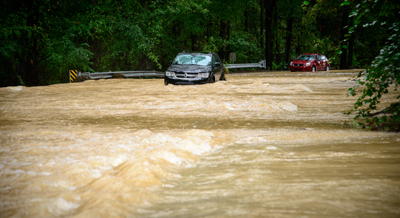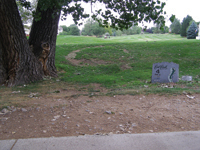From the October 2016 issue of GCM magazine:
Road to recovery
As a Colorado golf course learned, assistance can come from many corners — including FEMA — in the wake of a natural disaster.

Recovery mode: Taking time to process the situation and assess the damage after a disaster — such as significant flooding — hits a golf course can pay off in the form of substantial support from federal resources such as FEMA.
Photo by Matthew Orselli/Shutterstock.com
Ken Moum
Read this story in GCM's digital edition »
Remember that old joke that the worst thing that could happen at work would be showing up on a Monday morning to find a “60 Minutes” crew waiting for you? If you’re a golf course superintendent, that’s probably not what keeps you up at night. Rather, heading to the course after a massive rainstorm, wondering what kind of destruction it has left behind, may just be your worst nightmare.
And if you get there and discover hundreds of thousands — if not millions — of dollars in damage, your first instinct may be to set to work trying to get your course back in playing condition. But that actually may not be the best course of action — at least not according to golf course architect Kevin Norby, who has been involved in such post-disaster projects at several courses.
The reason? If you’re at a public course, you may be able to get some help in the recovery process. Over the past half-dozen years, the Federal Emergency Management Administration (FEMA) has implemented policies that give golf courses increased disaster-relief options — everything from assistance with infrastructure to the restoration of most turf and trees. Any work completed before FEMA gets involved, however, is not eligible for assistance (with exceptions under certain circumstances, such as work done to stabilize bridges or other structures in the interest of public safety).
So, you decide to hold off. What needs to happen next?
Calamity at Coal Creek
The state’s governor must first request that a federal emergency be declared by the White House. According to FEMA, the Robert T. Stafford Disaster Relief and Emergency Assistance Act requires, in part, that “all requests for a declaration by the President that a major disaster exists shall be made by the Governor of the affected State.” The experience of Coal Creek Golf Course, an 18-hole public facility owned and operated by the city of Louisville, Colo., is a perfect example of how this all works.
In early September 2013, Colorado endured record rainfall, which in turn resulted in devastating flooding. According to reporting from The Weather Channel, Boulder — not 10 miles up the road from Louisville — received 14.62 inches of rain in four days, beginning on Sept. 9. Nearly 10 inches of that fell on just one of those days, Sept. 12, and the resulting flash flooding impacted an area from Loveland to Aurora, a part of the country where the average annual rainfall is only about 15 inches.
The flood damage at Coal Creek was unprecedented. Built to withstand a 100-year flood, the course was hit by what officials estimated to be a 400-year rain event. A four-lane road with three underpasses bisects the course, and water backed up and picked up velocity going through the underpasses. It moved so fast that it ripped out chunks of concrete. In all, 40 bunkers were washed out, 14 greens and tee complexes were damaged, 25 acres of fairways were affected, three bridges were destroyed, and one of those underpasses was deemed impassable.
Colorado Gov. John Hickenlooper requested an expedited major disaster declaration on Sept. 14, and President Obama issued the federal declaration on the same day. On the following day, a federal coordinating officer was appointed to oversee the recovery. Because of the scale of the damage, FEMA waived requirements for a joint Preliminary Damage Assessment and got straight to work.
Initiating the process
Before the flood, a golf course management company had overseen operations at Coal Creek, but because the deluge essentially destroyed the property, there wasn’t much of a course to manage, and the city of Louisville took over those responsibilities. As luck would have it, the city of Louisville and Norby had begun working together on a long-range master plan for the golf course shortly before the flood, which gave them a bit of a head start on recovery efforts before Alan Gill, the parks and recreation project manager for the city, got involved.
Gill didn’t have previous experience with FEMA. He says the city jumped in to help stabilize the situation, and that FEMA representatives were quickly on the job. He soon realized that the disaster-recovery team had a way of working that was standard for all of their projects. “My take was that if we didn’t learn to communicate with FEMA using their terminology and document it their way, we weren’t going to get very far,” he says.
 |
 |
|
Coal Creek GC before the 2013 flooding. In a turn of fortune, shortly before the disaster hit, the city of Louisville had contracted with architect Kevin Norby to complete a long-range master plan to update and renovate Coal Creek, a process that proved beneficial when recovery efforts began.
|
Initially, Gill says, the city was told it would only be eligible for work done on the course’s infrastructure. But, in another lucky turn, just a week before the flooding, FEMA had issued a recovery policy statement that changed the guidelines, allowing for “grass and sod replacement if it is an integral part of the repair or replacement of the eligible recreational facility.” Coal Creek was likely the first golf course to receive funding for turf replacement through FEMA.
Along with receiving federal assistance, the city of Louisville initiated outreach that included gathering feedback from the golf course’s advisory board, Coal Creek golfers, local homeowner associations and Louisville residents, both golfers and non-golfers. From flood to finish, more than 30 public meetings were held, and Gill says encouraging and sustaining community involvement was vital to the reconstruction’s success.
Rebuilding with FEMA
Following the flood, the city issued a formal request for proposal, inviting submissions from an architect/contractor team who would do the renovation using a design/build process. Norby and his company partnered with Landscapes Unlimited, and the team was awarded the project based on its familiarity with the course. “We started with the master plan we’d previously done,” Norby says. “That plan identified the primary issue, which was the negative impact that trees were having on turf quality, safety and playability. There was shade and root encroachment, as well as narrowed playing corridors, etc. We also found that the irrigation was in very poor condition, with numerous leaks and inoperable heads.”
From there, Norby and Landscapes Unlimited did a hole-by-hole summary with drawings that showed the location and extent of the flood damage on each hole. They summarized quantities of damaged turf, cart paths and eroded bunkers, areas where the creek had pushed rock and sediment up into playable areas, and where bridges, irrigation satellites and the pump station were flooded.
“We then met FEMA representatives and presented the plans showing the damaged elements, as well as detailed cost estimates,” Norby says. “Because there were other elements that were not damaged by the flood that we wanted to repair — such as improvements to the driving range and replacement of irrigation heads — we listed the cost of various elements as ‘FEMA eligible’ and ‘FEMA ineligible.’”
After FEMA agreed to the scope and estimated costs of Norby’s plan, construction commenced. They broke ground in the spring of 2014 and wrapped up construction in the fall of 2014. Landscapes Unlimited completed the grow-in/turf maturation in the spring of 2015. The course opened for play in June 2015.
Post-project wisdom
Looking back on the events, Gill stresses the importance of documentation. “It’s the key to reimbursement,” he says. “They (FEMA) can pay up to 75 percent of the cost, but we got 46 percent because some of the things we did were capital improvement items. This is where Kevin was very helpful, and the hole-by-hole analysis of the flood damage and capital improvement items was invaluable. They documented the actual work to do, square footage, etc.”
According to Gill, FEMA reimbursement happens in two ways. “Our application had all the storm damage items and capital items. They give reimbursements based on the itemization,” he says. “It’s also possible to get an estimate for the whole project, take a lump-sum payment, then go build it, with the rest up to you. Our preference was to go the way we did so that if we found additional damage, we could apply for additional funding.”
Asked what he’d say to another city golf manager or superintendent who’s facing a similar catastrophe, Gill advises, “Don’t panic. Sit back and take in what’s going on.” A certain type of proactive approach will be beneficial, though. “Have a plan for what you might do. Look at FEMA’s site for how to put together an emergency management plan,” Gill says. “Meet with your state agency to help coordinate the process. It’s a major thing to have a plan in place so there’s a way to move ahead with the restoration.”
FEMA does promote the use of a master plan or an emergency preparedness plan, Gill says. “The fact that you have spent time thinking about this situation counts in your favor,” he adds.
Like starting from scratch
Even after the construction had kicked off, other post-disaster considerations emerged at Coal Creek. The U.S. Army Corps of Engineers was interested in water flows, Colorado Parks and Wildlife was interested in the fate of the threatened Preble’s meadow jumping mouse, and the builders had to look out for historic and cultural interests. Now, with the course open, Gill says the city is still working on the project with FEMA, completing more documentation, answering questions and making sure permits are closed. “In a few years we’ll have an audit, to make sure it was all done right,” he says.
David Dean, the superintendent at Coal Creek, didn’t have the trauma of being there when the flood hit, but was hired by the city of Louisville in September 2014, after construction work was well underway. Dean did participate in the grow-in, though, and the nine-year GCSAA member likens the endeavor to starting an entirely new golf course. “I was here for the construction of several greens, the practice facility, and a 22,000-square-foot punchbowl green,” Dean says. “I got to see irrigation go in on the first, second, third, ninth and 13th holes, and the practice facility go in, along with the bunker construction for those same holes, and the shaping and seeding of the fourth, eighth, 10th and 14th fairways.”
While Landscapes Unlimited was working on the renovation, Dean and his assistant superintendent, Alex Kosel, built and grew in a 10,000-square-foot nursery green. “One of the things I wanted to do when I finished school was to be part of a grow-in,” Dean says. “I just wish I’d been there to see more of it, from start to finish.”
Weathering the storm
Although FEMA funding isn’t typically available to non-public courses, the lessons learned through Coal Creek’s experience have value for private courses too. Norby and Gill both agree that immediately jumping in after a major disaster to try to get back in business as quickly as possible isn’t necessarily the best idea. Courses that have a master plan or disaster plan would do well to resist panicking and taking swift action. Instead, such a situation can be as good a time as any to make course changes that have already been thought out.

Back in action: Those involved in the Coal Creek GC recovery project emphasize the importance of documentation to the process of receiving proper funding from FEMA.
Another factor to consider is that many golf courses are part of larger watersheds, which may allow for the opportunity to work with and obtain additional funding from local conservation districts, city governments, state wildlife agencies or the U.S. Army Corps of Engineers. That’s exactly the case right now in Minnesota, where Norby is working with the Minneapolis Park and Recreation Board, FEMA and the local watershed district to fund a $6.5 million renovation at Meadowbrook Golf Course, which was ravaged by flooding in June 2014. The course is slated to reopen next year.
Ken Moum is a freelance writer based in Topeka, Kan., and a former GCSAA communications staff member.